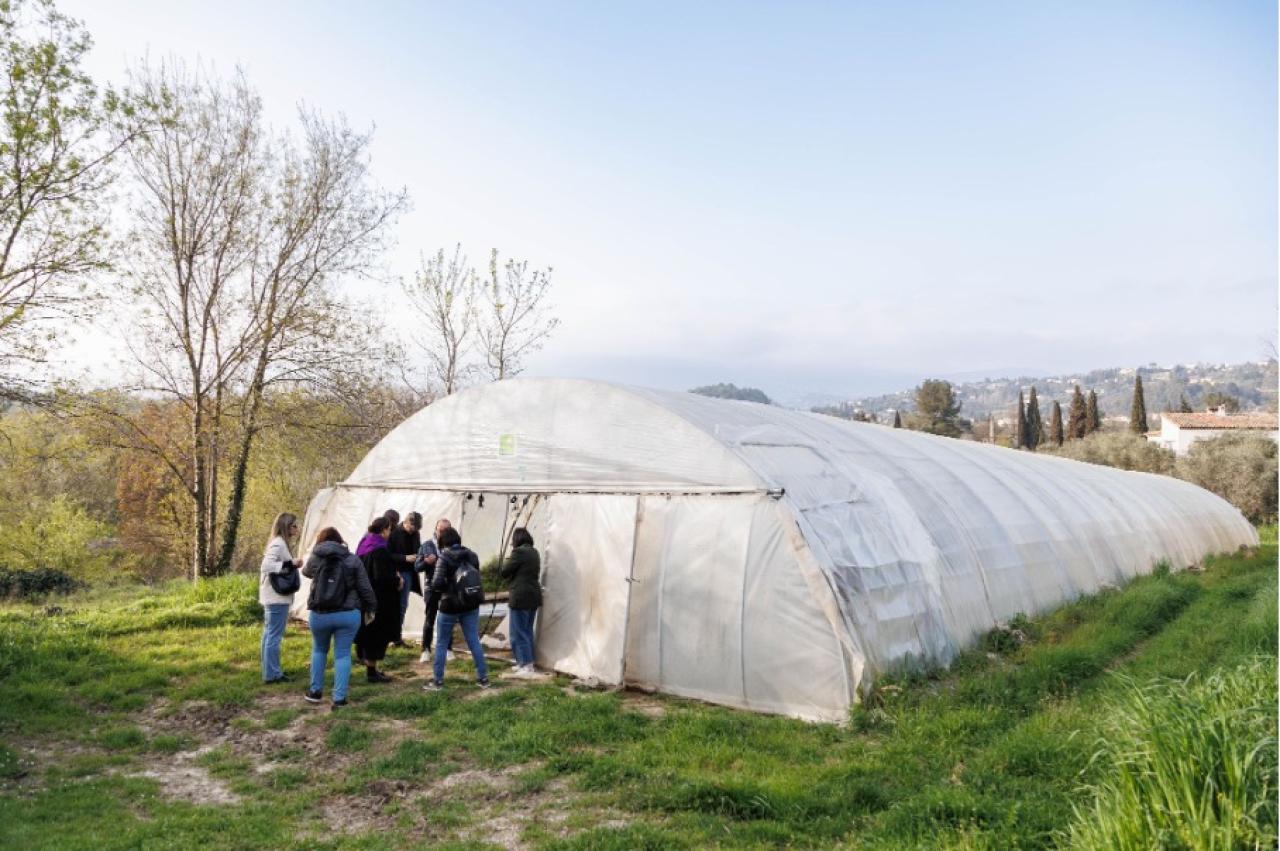In October 2024, Milan hosted the third EU City Lab on Local Food Systems, co-organised by URBACT and the European Urban Initiative (EUI). Now that we’ve had some time to digest the presentations, dialogues and site visits, what have we learnt about integrated sustainable food systems from Mouans-Sartoux (FR), Liège (BE), and most recently, Milan (IT)?
Discover an integrated, systemic approach to sustainable urban food systems as well as five transversal lessons learnt from the EU City Lab participants themselves.
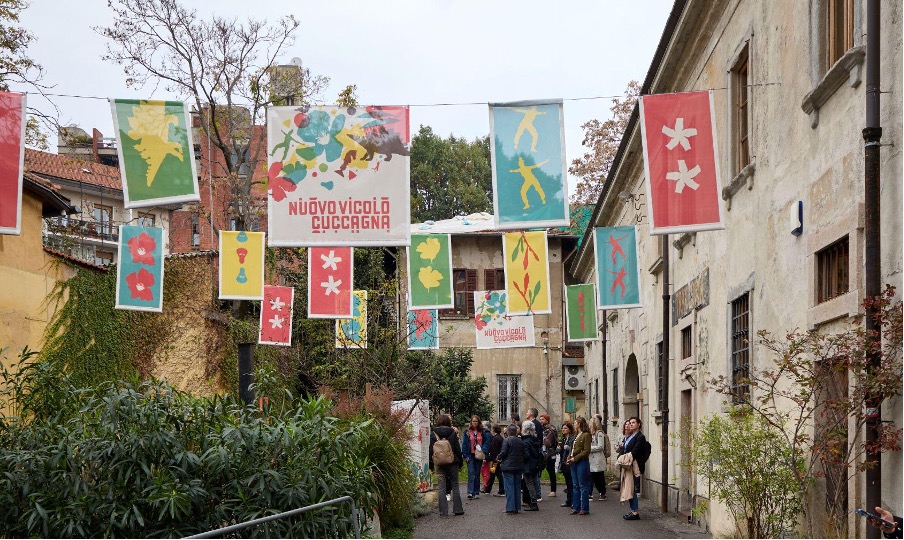
Visit of Cascina Cuccagna, a former farm now restructured in an urban social and sustainable food hub during the 3rd EU City Lab in Milan field visits. Photo credits: URBACT.
What is the EU City Lab recipe?
At a glance, EU City Labs are thematic events aimed at fostering city-to-city exchanges and building learning communities. To understand the outcomes of the last EU City Labs, it is worth considering the systemic approach to these events, with respect to the theme of food sustainability.
URBACT and the EUI are strong supporters of adopting an integrated approach to develop urban solutions to move towards more sustainable food systems. This approach served as the basis for all EU City Lab on Food Systems. Accordingly, three entry points into urban food systems were chosen:
• Changing eating habits to promote healthier diets, support local production and build food security and bolster supply chains in line with broader economic and social goals
• Food procurement to change governance mechanisms, local production and food habits
• Preserving agricultural land to feed city populations to improve local resilience, biodiversity protection, reduce environmental impact, support local economy, feed local canteens
In complex systems, such as local food systems, most of the variables are both driving change and dependent on change. Across the three events, it was important to underline how an integrated, systemic approach to local food systems works, to prompt the evolution of the whole system and, vice versa, to push changes in the system:
• Eating habits transition requires a city to act on all aspects of the food environment of its inhabitants from facilitating access to quality food in schools canteens, commercial restaurants and shops, stimulating home cooking or enabling experiences of self-growing food.
• Changing food procurement needs the involvement and transformation of all stakeholders, from city purchasing services, kitchen staff in canteens, farmers and catering logistics as well as children and their families.
• Preserving agricultural land to feed city populations requires a city to raise sensitivity to food sovereignty among inhabitants, to support existing farms and installation of new farmers, to cooperate with other territorial and regional governance levels around.
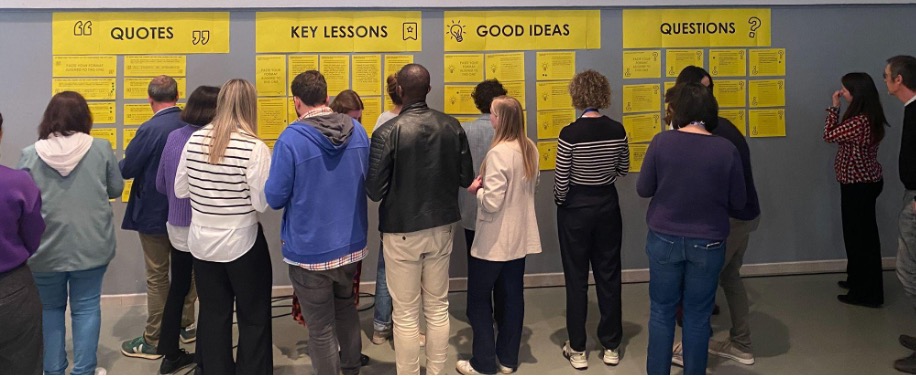
Collective lessons learned sharing process by participants at the end of the first EU City Lab in Mouans-Sartoux. Photo credits: François Jégou.
5 transversal lessons learnt from Mouans-Sartoux, Liège and Milan
At the end of each EU City Lab, a specific session was on what participants, both city practitioners and decision-makers, think is most useful. The synthesis presented below reflects the highlights from these sessions. The lessons learnt have been selected from the EU City Labs in Mouans-Sartoux (FR), Liège (BE) and Milan (IT), with quotes from the participants themselves.
1. There is never enough dialogue
To drive action, thinkers and doers need to talk to each other, but also make space for everyone’s voices – from the farmers to the elected representatives, including the planners, and grassroot movements. “Creating [a] dialogue is a motor for their action, to give a place to everyone’s voices, from the farmers to the elected representatives, including the planners, and the grassroot movements”, said Denise Cahill from Cork Healthy Cities.
• This starts by rising the inhabitants’ awareness which is an ongoing challenge, as Bo Vanbesien, from the Municipality of Roeselare (BE), said: “Moving the discourse from sustainability, which is an above ground concept, to health, which is perfectly understood by people, helps to engage the latter.”
• In Liège (BE), canteen professionals meet with local producers – and vice versa – to understand each other’s needs, adjust what needs to be produced/cooked.
• In Granollers (ES), potential farmers and landowners should liaise, e.g., with municipal support to identify the blockages and leverages to make land accessible to those in needs.
2. Transitions also require an integrated approach
In all three host cities, participants concluded on the same transversal approaches: “…build bridges [...] start where you are, use what you have [...] think beyond silos [...] interconnect all dynamics, etc.” With these commonsense claims, participants underlined the need to start with food transitioning everywhere at the same time, aiming at transforming the whole local food system, combining both long-term thinking/strategic planning and short-term doing/pragmatic approaches rather than opposing them.
• Cities like Mouans-Sartoux show how a long term clear and accessible political view on healthy and sustainable schools canteens is able to articulate and synergise lots of heterogeneous food projects, align food stakeholders’ initiatives, interconnect their competences.
• Following the example of public procurement in Liège, an integrated stakeholder consultation, as opposed to a top-down injunction from the city, is likely to support co-design transformation and shared public markets; namely, “...source local markets, build a fair dialogue with farmers to guide your procurement process…”
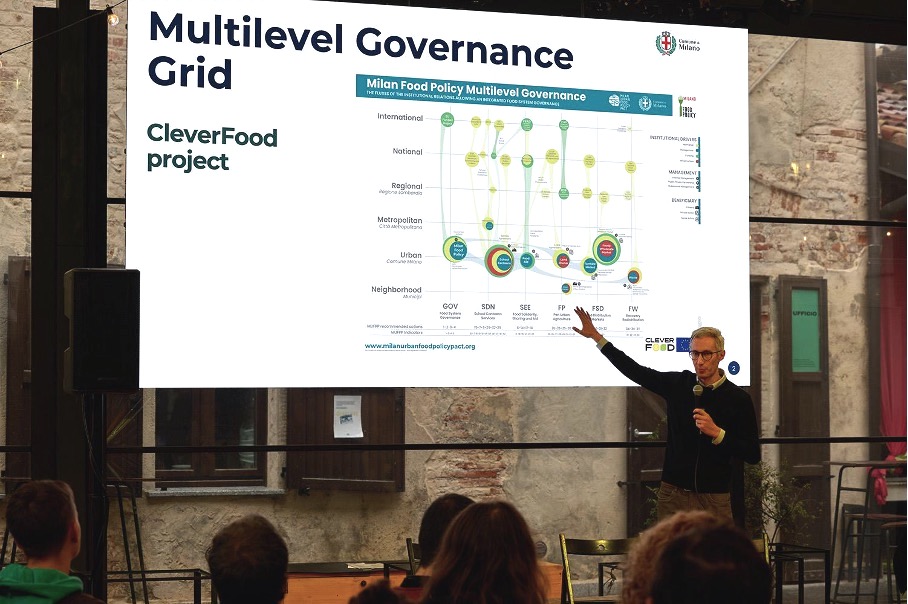
Andrea Magarini, Milan Food Policy Area, presenting a map of Milan Food Policy Multilevel Governance showing interaction of different dimensions of the food policy (governance, schools canteens, social solidarity, local production, distribution markets, etc.) at the various governance levels (neighbourhood, urban, metropolitan, regional, etc.). Photo credits: URBACT.
3. Decide how to use the legal framework
EU City Lab participants recognised difficulties to take action beyond cities’ administrative silos on the whole food system at the same time. EU and national legal frameworks sometimes receive criticism for hindering progress. But they might be where the solutions (and existing tools) are to ensure everybody is on board for the transition:
• In the Brussels-Capital Region, Milan, Liège, Mouans-Sartoux or Copenhagen, just to cite a few, procurement mechanisms, specifications and criteria can be used to support the purchase of more sustainable food.
• According to Marion Tanniou from France Urbaine, various legal tools, such as urban planning/zoning and protection perimeters, pre-emption and land portage or the support for collective tools, can be used to influence land ownership, land use or find buyers and support the emergence of a new business model.
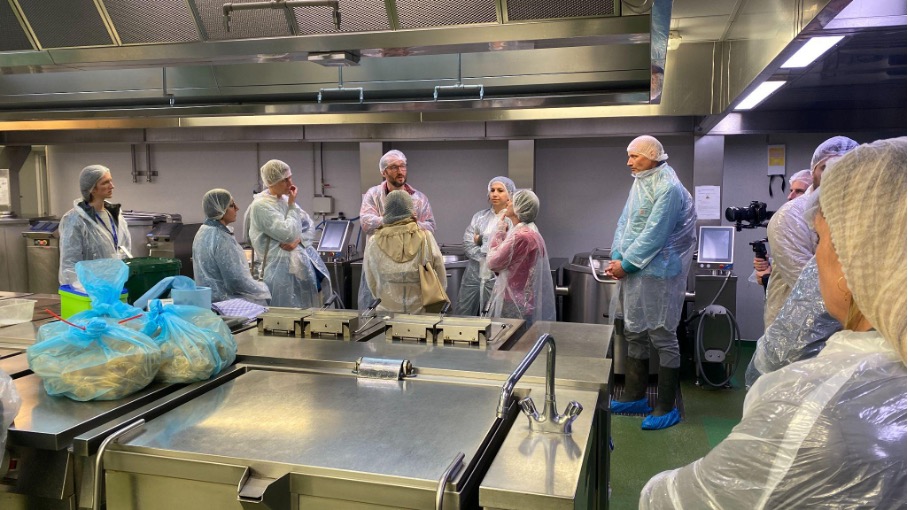
Visit of ISoSL inter-communal central kitchen during the EU City Lab in Liège. Photo credits: François Jégou.
4. Think and act in a systemic way
Changing food practices of the population requires acting on the entire food environment, the food sold in shops, served in the canteen, promoted in events, etc. “The food system transformation should be approached with a systemic idea of society, behaviours and choices…”. Systemic change requires for a city to really think and act in a systemic way, to map the initiatives, match dynamics, interconnect governance levels, look for gaps, build synergies.
• In Mouans-Sartoux, the education of children (and their parents) was highlighted: “Reach children through quality food, education, events, everything…”
• “We should question ourselves about words we use: healthy means a lot more than sustainable”. In discussions among participants, approaching food transition through the health angle embraces broader system perspectives from organic production lower impact on the environment to higher concerns of the population or more chance to leverage on health-related budget resources.
• Cities may spot and tap gaps to fluidify the local food system as for instance Liège building a Short Circuit Hub and a new Vegetable Processing Unit in order to provide missing logistic infrastructures to enable small local farmers to team and cater the large city central kitchen.
• Cities, such as Mouans-Sartoux or Milan, engage on preservation of agriculture land on their own urban territories and also beyond, interacting with higher territorial governance levels, i.e., Mouans-Sartoux led COOP InterPAT a national study focusing within the PAT (Territorial Food Plan) framework cooperation between cities, intercommunalities, county, region of the same food territory.
Changing food practices of the population requires acting on the entire food environment, the food sold in shops, served in the canteen, promoted in events, etc. “The food system transformation should be approached with a systemic idea of society, behaviours and choices…”. Systemic change requires for a city to really think and act in a systemic way, to map the initiatives, match dynamics, interconnect governance levels, look for gaps, build synergies.
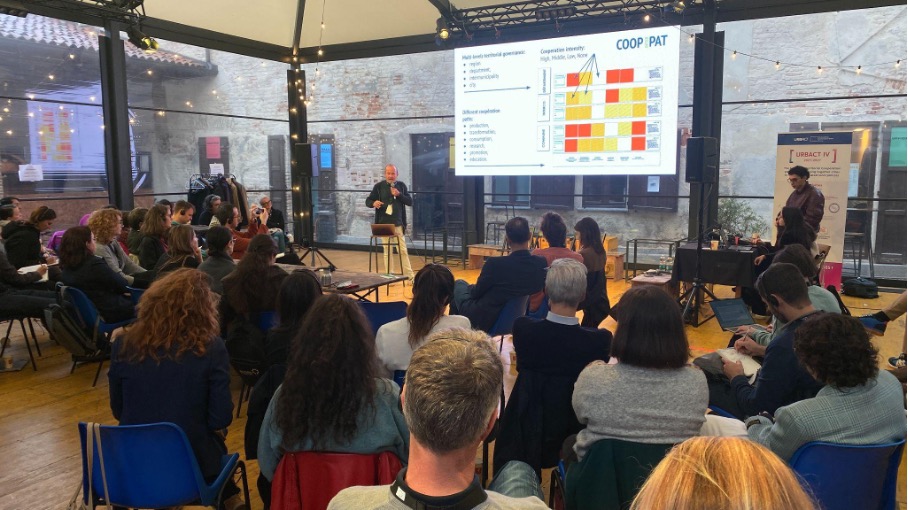
Gilles Perole presentation of the COOP InterPAT study co-designing a toolbox to explore and facilitate the cooperation on joint Food Territorial Plan in France. Photo credits: François Jégou.
5. Expressing purchase power can change local food practices
Although cities don’t have any (or very few) official competencies in terms of food, beyond a limited legal administrative framework, they are the right level near enough to local inhabitants and representing important stakes in territorial food and agriculture stakeholders' game to considerably influence local food transition. EU City Lab participants retained that “Sustainable public procurement can generate real economic, social, cultural, health and environmental benefits…”
• Cities can equip themselves with food governance instruments such as Food Policy Councils, ad-hoc services food (as Mouans-Sartoux Sustainable Food Education Centre or Milan Food Policy Area).
• Cities with large central kitchens, like Liège or Milan, are able to express their purchasing power in strategic food procurement and trigger change in food production, raising local quality standards, engaging the population in more healthy and sustainable food practices.
• Beyond influencing the local territorial food game, cities also engage in lobbying at national and international level to change the conventional agro-food system: teaming cities around the Milan Urban Food Policy Pact, advocating as Mouans-Sartoux for a European food exception, engaging with universities in research on food transition scenarios in Milan and as Mouans-Sartoux in setting specific civil servant education programs on sustainable and healthy food.
Closing the tab
The lessons learnt from the three EU City Labs on Local Food Systems further exemplify that the integrated approach requires to work both ways: choosing catchy entry points such as changing eating habits, food procurement or land use to ensure participants get into the food system and also making sure thar all these topics that “don’t stay in silo…” and resonate with all the dimensions of local food systems.
This article is only a snapshot of the tremendous exchanges which took place during the three EU City Labs on Local Food Systems! If you wish to know about specific elements, check the embedded links or consult the dedicated event pages:
• EU City Lab on Changing Habits for a Healthy and Sustainable Food System, 21-22 March 2024, Mouans-Sartoux
• EU City Lab on Public Procurement for More Local, Seasonal and Sustainable Food, 29-30 May 2024, Liège
• EU City Lab on Land Strategies to Feed the City, 23-24 October 2024, Milan
The next EU City Lab will focus on a different thematic area: funding the energy transition. It will take place on 20-21 November 2024 in Bucharest. More information on registration and the agenda can be found here.
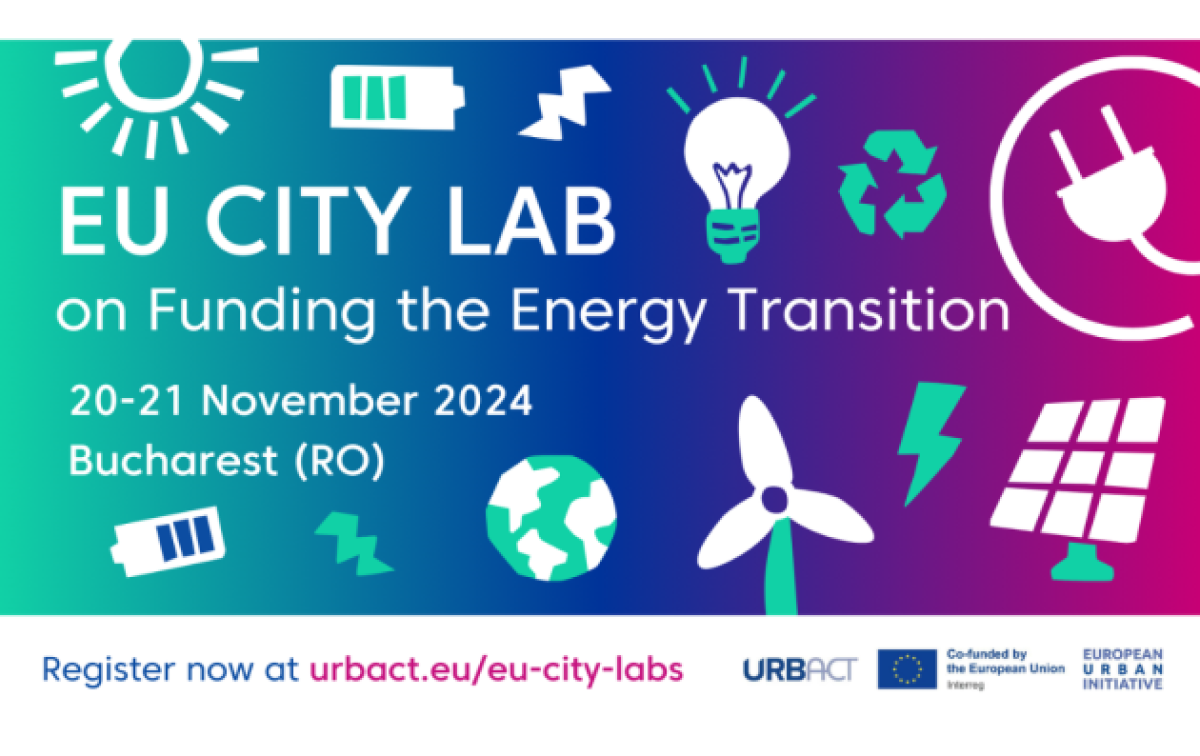
This article was authored by: Marcelline Bonneau and François Jégou.

